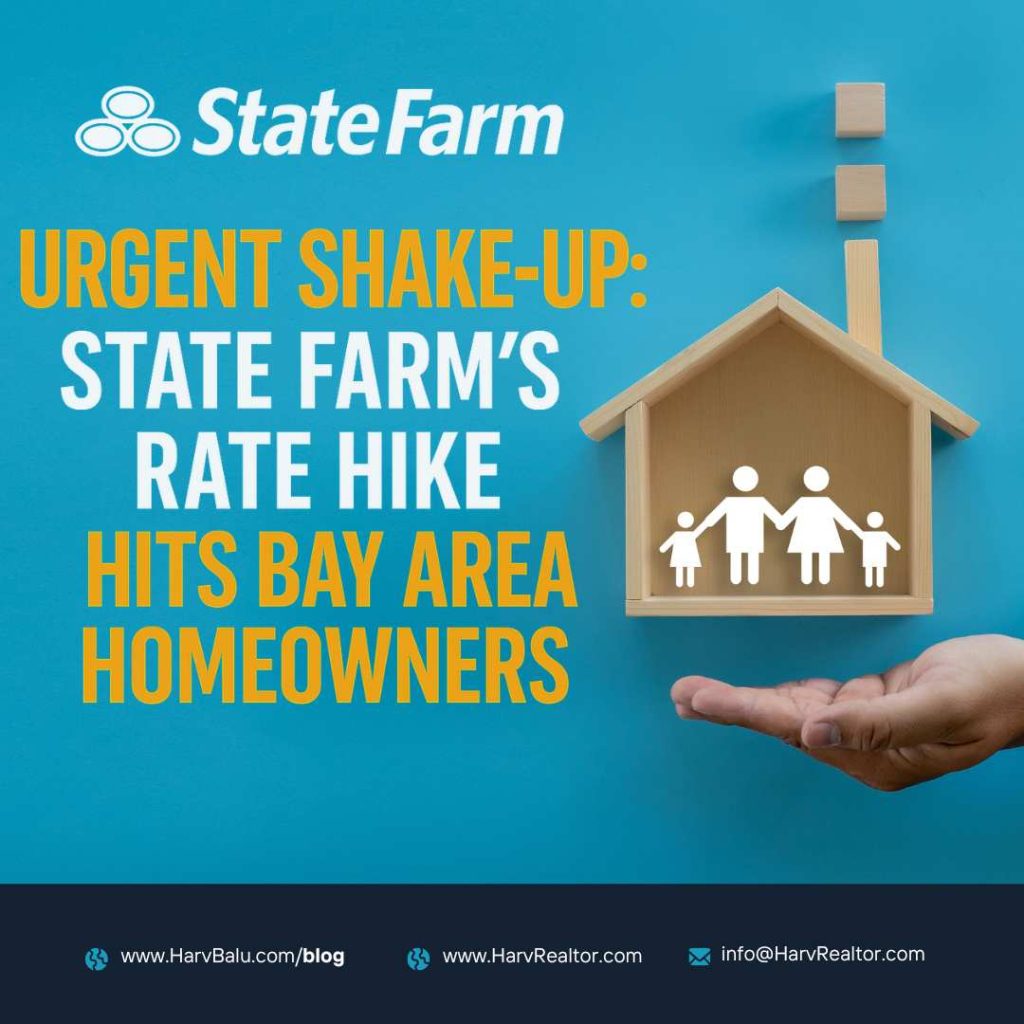Critical Update: How State Farm’s Emergency Rate Hike Could Impact Your Bay Area Home
State Farm Emergency Rate: California homeowners are bracing for a steep jump in insurance premiums this summer as State Farm – the state’s largest property insurer – has received approval for an emergency interim rate hike effective June 1st. Starting next month, State Farm will raise premiums by an average of 17% for homeowners, 15% for condo and renters policies, and up to 38% for rental dwelling (landlord) coverage (source: northbaybusinessjournal.com).
This marks the first time California regulators have ever granted an interim “emergency” rate increase to an insurer ahead of the normal review process (source: insurancenewsnet.com). The unprecedented hike comes after State Farm faced over $7 billion in claims from destructive Los Angeles County wildfires this January, a financial hit that the company says put it in distress (source: insurancenewsnet.com).
The decision, approved by the California Department of Insurance and an administrative law judge, is generating controversy and consumer backlash – and it could impact homeowners across the Bay Area, from Fremont and Milpitas to San Jose and Hayward.

Why Is State Farm Hiking Rates Now ?
The emergency rate hike didn’t happen in a vacuum. State Farm cited massive losses from the January 2025 LA County wildfires as the catalyst for its request. Those fires, which struck communities in Pacific Palisades and Altadena, led to nearly $8 billion in insurance claims for State Farm (source: insurancenewsnet.com). The company argued that without a significant rate increase, it would struggle to remain solvent and continue serving customers. In fact, State Farm initially sought a 22% rate hike for homeowners in February (source: northbaybusinessjournal.com), but scaled down the request to 17% during negotiations (source:northbaybusinessjournal.com). Even at the lower percentage, the emergency interim increase is “highly unusual,” according to the judge who heard the case (northbaybusinessjournal.com).
Normally, under California’s Proposition 103 consumer-protection law, insurers must justify any rate increase in a full public hearing before new rates take effect (source: abc7news.com). In this case, however, Insurance Commissioner Ricardo Lara made an exception due to what he called a statewide insurance crisis. “We are in a statewide insurance crisis affecting millions of Californians. Taking this on requires tough decisions,” Lara said in defending the difficult call (source: insurancenewsnet.com).
In granting conditional approval, Commissioner Lara required State Farm to bolster its finances by securing a $400 million cash infusion from its parent company and to halt any further mass policy non-renewals in California (source: northbaybusinessjournal.com). State Farm, which insures about 1.2 million homeowners across the state (source: insurancenewsnet.com) (roughly 20% of California’s home insurance policies (source: northbaybusinessjournal.com), agreed to these terms.
The company stated that the interim hike is a “critical first step” to ensure it can keep paying claims and serving customers in high-risk markets (source: abc7news.comabc7news.com).
How Will This Rate Increase Affect Bay Area Homeowners?
If you’re a Bay Area homeowner (or renter) insured with State Farm, expect to see a noticeable uptick in your premium. The approved increases – 17% for homeowners, 15% for condo owners and renters, and up to 38% for rental properties – will hit renewals and new rates starting June 1st (source:northbaybusinessjournal.com).
For an average California homeowner, a 17% hike translates to roughly $468 more per year (about $40 extra per month) on their insurance bill (source:insurancenewsnet.com). Renters and condo owners might pay around $57 more annually, and landlords with rental dwelling policies could see approximately $451 more per year in costs (source:insurancenewsnet.com).
Importantly, these increases apply statewide. Even though the wildfires prompting the hike were in Los Angeles, insurance rates in Fremont, Newark, Union City, Milpitas, San Jose, Hayward and beyond are affected. Insurers pool risk across California, so Bay Area homeowners will share the cost of catastrophic losses elsewhere. If you have a mortgage, remember that higher insurance premiums can slightly raise your escrow payments or total monthly homeownership costs – something to budget for if you’re planning to buy a home in the Bay Area real estate market. Homebuyers should get updated insurance quotes during their purchase process, since last year’s rate estimates may no longer be accurate after this hike.
Investors and landlords should also take note. A nearly 40% jump in landlord insurance premiums could cut into rental property cash flow. Over time, some owners might feel pressure to pass on a portion of these costs to tenants (where leases allow), potentially nudging rents upward. If you own rental units in San Jose or Fremont/Milpitas areas, it’s wise to review your insurance coverage and factor the new rates into your investment returns. And for renters, while a 15% increase in renters insurance might only be a few dollars a month, it’s a good reminder to shop around for competitive rates or bundle your renters policy with auto for a discount.
Consumer advocates warn that this may not be the last increase, and other insurers could file similar emergency requests. California’s insurance market has been under strain from repeated wildfire disasters, so even homeowners not insured with State Farm should stay informed.
Several major insurers have already been seeking significant rate increases or reducing coverage in high-risk areas (source:northbaybusinessjournal.com). In short, home insurance costs are rising across the board, and Bay Area homeowners need to be prepared.
Tips for Navigating Rising Insurance Premiums
With insurance premiums on the rise, what can Bay Area homeowners, buyers, and investors do to manage these higher costs? Here are some practical tips to help navigate the situation:
Shop Around for the Best Rate: Don’t accept the first renewal quote blindly. Compare Bay Area homeowners insurance rates from multiple companies. Some insurers may offer a better deal for the same coverage, so it pays to get quotes. Independent insurance agents or online comparison tools can help you find competitive premiums.
Ask About Discounts: Inquire about available discounts. Many insurers offer lower rates if you bundle your home insurance with an auto policy or if you have safety features like alarm systems, smoke detectors, or sprinklers installed. You might also get discounts for being claim-free or loyalty discounts for staying with a company, so ask what you’re eligible for.
Consider a Higher Deductible: Raising your deductible (the amount you pay out-of-pocket on a claim) can significantly lower your premium (source:iii.org). For example, increasing from a $500 to a $1,000 deductible could save you up to 20–25% (source: iii.org) on premiums. Just be sure you have enough savings set aside to cover that larger deductible if you need to file a claim.
Review and Update Your Coverage: Make sure you’re not over-insuring. Your coverage amount should reflect rebuilding costs of your home, not the market value of the land (source: iii.org). If your policy has extras you don’t need (such as riders for high-value items you no longer own), adjust them. However, never under-insure your home – you want enough coverage to rebuild after a disaster.
Improve Your Home’s Resilience: Taking steps to harden your home against disasters can pay off in the long run. Clearing brush and improving fire resistance (for homes near wildland areas), installing fire-resistant roofing, or upgrading plumbing and electrical systems can reduce risk (source:iii.org). Some insurers will lower premiums for homes with safety upgrades or superior construction. At minimum, these improvements help protect your property and could prevent costly claims.
Work With a Knowledgeable Agent: An insurance agent or broker who understands the California market can guide you through this tricky time. They can help tailor your coverage to your needs and advise on new developments (for example, any state-sponsored programs or mitigation credits). Don’t hesitate to consult an expert – and if you’re a Bay Area Realty Experts client, we can connect you with trusted insurance professionals in our network for advice.
By implementing these strategies, you can cushion the impact of rising insurance costs and make sure you’re still getting good value and proper protection for your home.
Will Higher Insurance Costs Affect the Real Estate Market in Fremont, Milpitas, San Jose?
In high-cost regions like the Bay Area, any increase in homeownership expenses raises the question: Could this impact our real estate market? So far, the real estate market in Fremont, Milpitas, San Jose and surrounding cities remains strong, driven by tight housing supply and buyer demand. A bump in insurance premiums (even ~$40/month for many homeowners) is relatively small compared to mortgage payments in these markets. It’s unlikely by itself to deter most home buyers. However, there are a few indirect effects to watch:
Homebuyer Calculations: Lenders factor insurance into the debt-to-income calculations for a mortgage. Higher insurance premiums mean slightly higher monthly obligations, which could marginally affect how much some buyers can afford. Especially for first-time buyers on the edge of approval, every bit counts. Prospective buyers in Hayward, Union City, or Newark, for instance, should get updated insurance quotes for homes they’re serious about, so there are no surprises in the closing process.
Buyer Confidence and Perceived Risk: News of rising insurance rates may prompt buyers to ask more questions about a home’s risk factors. We might see increased attention to hazard reports, fire history, or the availability and cost of insurance in a given area. For example, a home in a wooded hillside area near Fremont or San Jose might face higher fire insurance premiums; informed buyers will factor that in. Sellers and agents should be prepared with information on how a property has been mitigated for fire or other risks if applicable.
Investment Property Yields: As mentioned, landlords in the Bay Area will face higher insurance expenses too. While the Bay Area rental market is robust, property investors will calculate these costs into their return on investment. In markets like San Jose and Fremont, where home prices and property taxes are already high, an increase in insurance is another line item affecting net income. This might make some investors a bit more cautious or prompt slight rent increases over time to offset the expenses.
Long-Term Market Trends: If insurance costs continue to climb year after year (or if certain high-risk zones become nearly uninsurable), there could be a longer-term chilling effect on real estate in those specific areas. California officials are working on broader insurance reforms to stabilize the market, so tune in to updates. In the near term, though, the Bay Area’s major population centers (like the cities we serve: Fremont, Milpitas, Newark, Union City, San Jose, Hayward, and beyond) aren’t likely to see a downturn solely because of this insurance rate hike. It’s one factor among many in the cost of homeownership.
In summary, rising insurance premiums add a bit of headwind for homebuyers and owners, but they are just one part of the overall housing picture. Being proactive – by budgeting for the increase, shopping for good rates, and hardening your home against risks – will ensure this new development doesn’t catch you off guard.
Stay Informed – Tune In to Our Podcast for More Insights
The insurance landscape in California is changing quickly, and it’s more important than ever to stay informed as a homeowner or real estate investor. We’ll be diving deeper into this State Farm rate hike in California and what it means for Bay Area residents in an upcoming episode of the Bay Area Realty Experts Podcast. Be sure to tune in for expert insights, real-world examples, and tips on protecting your real estate investments.
Bay Area Realty Experts is your go-to resource for navigating the Bay Area real estate market – from Fremont to San Jose and everywhere in between. Subscribe to our podcast and blog for the latest updates on housing trends, market news, and practical advice to help you thrive as a homeowner or buyer. With changes like these insurance hikes, knowledge is power. Stay savvy, stay prepared, and as always, feel free to reach out to our team if you have questions about buying or selling in this evolving market.
Thank you for reading! We hope this overview helped explain the State Farm insurance rate hike and provided some useful guidance. Don’t forget to catch our podcast for more Bay Area real estate insights, and stay safe and informed!
Find Your Perfect Property: https://HarvRealtor.com
Alameda County : Latest Inventory & Updates:
https://Harvinder.dscloud.me/blog/reports-by-cities/alameda-county/
In-Depth Alameda County Real Estate Inventory (interactive):
https://Harvinder.dscloud.me/blog/alameda-real-estate-interactive/
Santa Clara County : Latest Inventory & Updates:
https://Harvinder.dscloud.me/blog/reports-by-cities/santa-clara-inventory/
Link for this post:
https://harvinder.dscloud.me/blog/05/15/2025/state-farms-insurance/

Related Posts

Unlock Lucrative Deals in Milpitas’ Booming Real Estate Market! 2024

Open House at 503 Cloverbrook Dr, Danville: Spacious, and Energy Efficient

Newark, CA – Insights into the Hot Real Estate Market: Low Inventory, High Demand🔥 and Rising Prices 💰
About The Author
Harv
HarvRealtor.com | Harv Balu, CIPS, GRI, FTBS, PSA | Tech-savvy Realtor & proud father of 3, committed to seamless real estate journeys. With 15+yrs in IT & passion for real estate, I offer tailored services. Enthusiast photographer, green-thumbed gardener.
